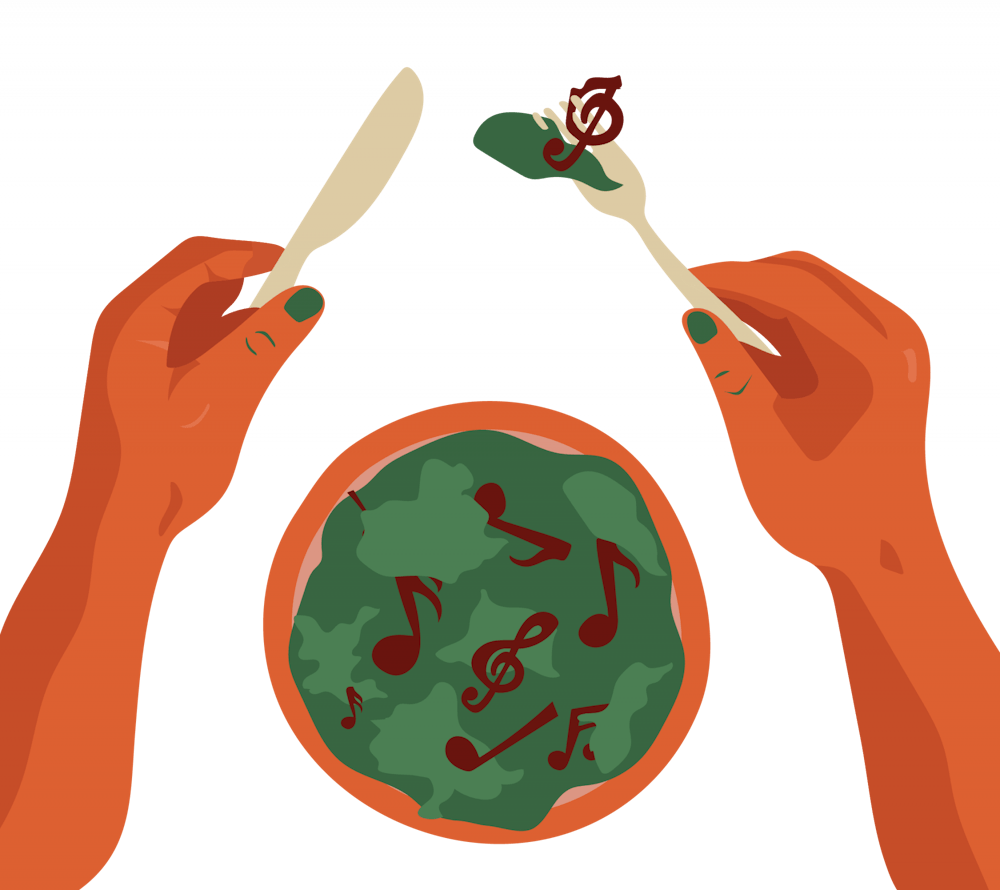A few years ago, my mom visited Royal Izakaya, a Japanese bistro in Old City. She described a warm atmosphere, good food, and an overall positive experience, but she was especially excited to hear several of her favorite songs on the restaurant’s playlist: “Can I Kick It?” by A Tribe Called Quest, “Brown Sugar” by D’Angelo, and the entirety of The Miseducation of Lauryn Hill. She asked the manager for the playlist, he sent her a Spotify link, and she kept listening for months after her meal. My mom’s R&B throwbacks listening spree was the most defining part of her dining experience that night.
There’s more to eating than the food on our plates. According to a 2018 study conducted by the European Journal of Marketing, the music we listen to while dining heavily influences our eating patterns and processes. Sixty participants were given two of the same cookies, one with “pleasant” music playing in the background and the other with “unpleasant” music. At the end, the participants deemed the first cookie as better tasting than the second, despite them being identical.
But you don’t need scientific explanations for the connection between food, music, and the brain to explain why restaurant music matters. Through eating and sharing food with others, we create memories to associate with our dishes. The music is an audible reminder of moments we share with others and our meals, from a quick lunch before class to a five–star birthday dinner.
Robert Collins, a New York City–based filmmaker and restaurateur, is a lover of all things food and music. He describes sound and music as “addictive,” and says it contributes to just about every human experience. Despite never playing an instrument himself, Collins has curated playlists for every restaurant, hotel lobby, and museum he’s worked in.
Collins owns Jue Lan Club, an upscale Chinese–fusion restaurant in the former Limelight nightclub in Chelsea. He describes the playlists at Jue Lan as “hip–hop–driven,” catering to its young and energetic clientele and atmosphere. Collins walks me through a typical night, in music, at Jue Lan Club.
“We start off, in the afternoon, a little more old–school. You’ll get anything from Al Green, to Michael Jackson, to Aretha Franklin,” Collins says. “As the day goes on, you might get a little Ja Rule, a little 50 Cent. Then, we take it up a bit more, and as the night goes on, you get more modern stuff … you got Drake, Lil Yachty, and Lil Baby.”
It wasn’t always possible to press play on a Pandora channel or carefully curated playlist. At the start of Collins’ career, he relied on iTunes to fill the lobby of The Mercer hotel in SoHo with music.
“I would go through iTunes, and I bought 15,000 songs myself … I had a whole huge collection,” Collins says. “I would literally curate [the playlists] to every half hour. When I picked a song, I’d put it into its proper place [in the night]. I’d be like, ‘Wow that’s a great eight o’clock song!’”
Now, Collins has an easier role as resident restaurant playlister. He often uses Pandora to find stations he enjoys, and tweaks them by adding, removing, and reordering the songs. Whether they know it or not, Jue Lan Club’s patrons are all avid listeners of the Pandora station for TLC’s 1990s hit “No Scrubs,” a personal favorite of Collins’.
Michael Kaplan is a professor of neuroscience at Penn who studies the intersection of music and the brain. Instead of referring to any of the various studies of music and its impact on our eating experience, he encourages us to look at food and music as one and the same, in terms of neuroscience.
“Music, food, and most of the other things we love are all pushing the same buttons,” says Kaplan. “Combinations of dopamine shots here and there, endogenous opiates, and other things in various combinations.”
Kaplan focuses on music as a method of social signaling. By listening to a certain kind of music, we’re telling the world “what group [we] belong to.” This mentality helps restaurants decide what music to play, identifying their intended audience and atmosphere through sound.
“Music is like a T–shirt that we wear to tell the world what kind of person we are,” says Kaplan.
In contrast, Collins believes that restaurants should curate playlists to reach beyond their intended audience. He playfully offers a hypothetical situation where a uniform playlist can negatively impact a restaurant’s business.
“I’ll go to some edgy pizza place in the East Village, and they’re only playing grunge music, cranking it up, because that’s what [the employees] like and want to hear. … And it might be OK for a few songs, but after a while, you might not psychologically want to come back next time because they decided to play the whole Metallica tape.”
Music streaming platforms have also capitalized on restaurant playlisting. Spotify offers several playlists fit for every type of dinner party in existence: Chill Dinner, complete with soft indie favorites; Soulful Dinner, a playlist fit for an afternoon at Jue Lan Club; and several others. Additionally, the Dinner Party Mix, curated by the Spotify algorithm, creates a dinner party playlist unique to each user.
Music is essential to our experiences with food, offering a backtrack to enjoying memories with every dish. Apart from taking orders and serving us food, restaurants are responsible for adding more than just the noise of conversation to a dining room. According to neuroscientists and restaurant owners alike, the music we listen to while we eat determines if we’d rather continue to enjoy our meal or leave the restaurant as soon as possible, packaging our leftovers into to–go containers.
Street took our own crack at throwing together a dinner playlist that can bring some of our favorites to your next gathering of friends. Check it out below.

